The observed influence of gamma-ray bursts on Earth’s magnetic field
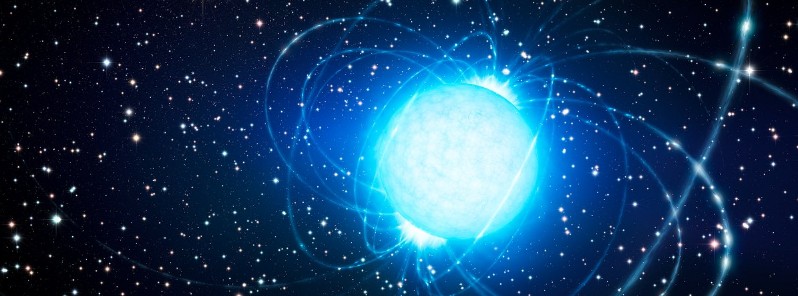
Gamma Ray Bursts (GRBs) are the brightest explosions in the Universe. They are detected by orbiting space telescopes at the rate of about one a day. The number that could be detected from Earth should be much higher than the current rate, but the efficiency of the instruments is the obstacle. In spite of the fact that GRBs are regularly observed, they are still a mystery in physics.
The mechanism by which they convert energy into radiation remains a dark puzzle. Neither the light curves nor the early-time spectra of GRBs can be explained with the currently known physical processes. However, strong GRB from within our galaxy can induce serious damage on the heliosphere and can destroy Earth's magnetosphere.
Introduction
There’s no theoretical model that truly explains any physical features of these intense energetic events. The current theoretical notions do not match the observations, even with constant tweaking and bending of some of the basic concepts that supposed to explain the physical mechanism of GRBs. A successful model has to explain the durations, light spectra, and other characteristics observed in the optical afterglow. But, constructing a model, that can explain the phenomenon of GRBs is an impossible task under the physics of gravity dominated Cosmos. These extremely bright explosions are supposed to be the result of Supernova, Hypernova (Superluminous Supernova), Neutron Star (a massive star collapses at the end of its life), a merger of Neutron Stars and a very recently new source has been added.
The immediate vicinity of supermassive Black Holes at the centers of blazars. In physical reality, Black Holes and Neutron Stars have no empirical counterparts. They are the fantasies of theoretical mathematicians (manipulations of mathematics), who did not understand the underlying physical principles of gravity. Recent observations have shattered to the core the theory of interstellar structure (star formation). These observations show that a star is not born through the gradual collapse of a cloud of interstellar matter. When gravity is understood in terms of the magnetic structure of matter, then it will be obvious that Black Holes and Neutron Stars are impossible to exist.
Based on many observations, the spectra of GRBs has been shown to be the result of emission of X-rays from highly excited ions and from fast electrons. The afterglow – the slowly fading emission that can be seen at all wavelengths (including visible light), for a few days to weeks – is produced by fast moving electrons. These electrons are accelerated to tremendous energy. But, what causes the tremendous acceleration of electrons and how they are accelerated is not understood or can be explained by current theories. Very recently, a research on the afterglow of GRB 121024A detected by the Swift satellite, using the Very Large Telescope (VLT) in Chile, has ruled out the existing theoretical predictions of how electrons are accelerated within the afterglow. K. Wiersema, a team leader of the research said: "Different theories for electron acceleration and light emission within the afterglow all predict different levels of linear polarization, but theories all agreed that there should not be a circular polarization in visible light. We measured both the linear and circular polarization of an afterglow with high accuracy. Much to our surprise we clearly detected circular polarization, while theories predicted we should not see any at all. We believe the most likely explanation is that the exact way in which electrons are accelerated within the afterglow shockwave is different from what we always thought. It is a very nice example of observations ruling out most of the existing theoretical predictions. We believe that this detection means that most of the current theories of how electrons get accelerated in the afterglow need re-examining."
The emitted radiation of GRBs and its characteristics can only be explained by the Plasma Pinch Discharge Mechanism (PPDM). This process can explain not only the acceleration of electrons within the afterglow shockwave but also other features of GRBs that are without any interpretation. The PPDM is a disruptive discharge of magnetic energy which is stored in a double layer (plasma). The disruptive discharge will cause the plasma cable to pinch into a very narrow column by an inward magnetic pressure of the discharge current. As a result of that, large-voltage and high-temperature discharge column will generate high energy gamma photons (superflare), based on the principle of ICS (Intense Compton Scattering), between the accelerated electrons and thermal photons.
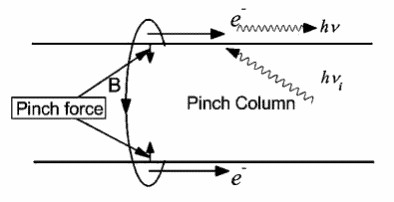
Pinch discharge model of GRBs.
The PPDM is also the process responsible for solar flares. Alfven and Carlqvist correctly suggested that exploding discharge of double layers is the cause of the eruption of a solar flare. The model of Alfven and Carlqvist is superior compared to the standard solar model. It can explain some basic features of the Sun, like the eruption of a solar flare and the acceleration of solar wind. In fact, all energetic explosive phenomena, such as the intense gamma-ray flashes, that have an atmospheric origin, solar flares, supernovae, GRBs and many others, including the most intense radiations that originate from the centers of galaxies, behave in much the same manner and obey the same principles. All these energetic phenomena and their associated radiations are produced, emitted and propagate as a result of magnetic interactions. Thus, only knowledge based on plasma physics can explain the physical properties and dynamical behavior of Cosmic radiations.
However, the flaws in current theoretical physics regarding GRBs are not only restricted to the process that generates them or to their optical properties, but also to their velocity and dynamical behavior in general. Like all magnetic radiations, GRB travel on magnetic fields, which are continuous throughout the Universe. At the location of the GRB, the velocity of the gamma ray photons is far exceeding the so-called speed of light (C). The gamma ray photons at the point of origin propagate with very many times, most likely millions of times the so called speed of light. The higher is the strength of the magnetic field surrounding the explosion, the higher is the luminosity (brightness) and the higher is the ejected particles velocity. As those particles start to propagate through space, their velocity decreases as they would be deflected by magnetic fields similar to the deceleration of starlight in the dense plasma that surrounds our star. The dense plasma surrounding the Sun has been recently confirmed by Voyager 1. In addition to many decelerations, the gamma photons will be scattered by dust and cosmic rays. For these reasons, the velocity of gamma ray particles would be reduced enormously by the time they reach the Solar System. The important question about GRBs, after this short introduction, is whether they could have an impact on our planet. The answer is yes. In fact, the impact of GRBs that take place within our own galaxy could be far higher than any solar flare.
Discussion and analysis
Eleven and half years ago, on December 27, 2004, several spacecraft recorded the brightest GRB ever. Some of NASA’s well known earth-orbiting satellites that recorded the event were RHESSI, INTEGRAL, and Swift satellite. Beside satellites, the interplanetary probes such as Cassini, Mars Odyssey, and Ulysses also observed the event. That brightest event was a GRB, originating from the so-called Magnetar, named SGR 1806-20.
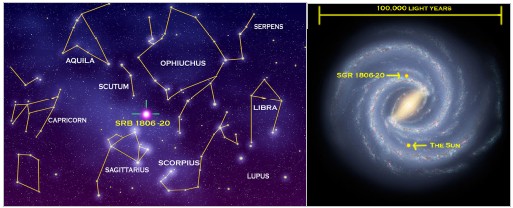
SGR 1806-20 Location. Source: Wikipedia
Magnetars are believed to be special kind of neutron stars, that have the strongest magnetic fields in the Universe. According to the analysis of NASA scientists, the superflare of SGR 1806-20, generated an amount of energy equal to what the Sun produces in 250 000 years. The belief of this colossal energy released is relying on the estimated distance of the blast location.
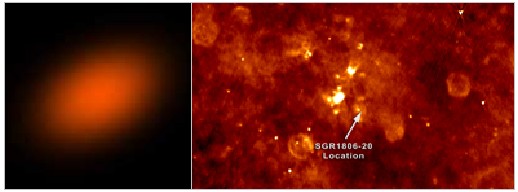
The left image is a model based on radio observations from the Very Large Array, shows the fading afterglow of SGR 1806–20's superflare. Courtesy NRAO / CfA / Bryan Gaensler. The right one is a high resolution, wide-field image of the area around SGR1806-20 as seen in radio wavelength. SGR 1806-20 can not be seen in this image generated from earlier radio data, taken when SGR1806-20 was “radio quiet.” The arrow locates the position of SGR 1806-20 within the image. Credit: University of Hawaii.
But, the current Cosmological distance calculation cannot possibly be correct. It is based on the wrong notion of the constant speed of light and the misunderstanding of the redshift. In the case of light coming from cosmological objects, the Lyman-a line is shifted to longer wavelengths (lob), and this shift is attributed to the expansion of the Universe (hence the object is moving away from Earth), supporting the Big Bang theory. The redshift z is the increase in wavelength relative to the rest wavelength. z = (lob – lrest) lrest. The hypothesis that the redshift is a representation of cosmological distance, particularly in cases of redshift values bigger than 0.3 is a wrong assumption. Hubble’s relationship is only linear below a redshift of 0.1.
However, the GRB from SGR 1806-20 reached its peak intensity in just two-tenths of a second. During this time interval, the blast outshone the full Moon by a factor of two. The Russian Helicon-Coronas-F satellite saw it reflected off the surface of the Moon, a very poor mirror. In fact, the explosion was so intense that even the Swift satellite, which was designed to detect gamma ray bursts, was totally saturated by the number of photons-per second hitting its detectors. The saturation happened although the spacecraft was not pointed to the direction of the galactic blast. David Palmer, a Swift scientist, could only draw an approximation of the light curve:

Fig.1 Light curve of Swift’s Burst Alert Telescope
D. Palmer said: "This is the light curve that [Swift’s Burst Alert Telescope] saw, showing how many gamma rays it counted in each sixteenth of a second during six minutes of observation. I didn’t draw the main spike because it was 10,000 times as bright as the tail emission, and you would need a monitor a thousand feet tall to look at it."
Fig.2 (below) shows the light curve of the superflare at X-ray energies of 20,000 to 50,000 eV. The detected data is based on NASA’s RHESSI satellite. RHESSI was designed to observe solar flares.
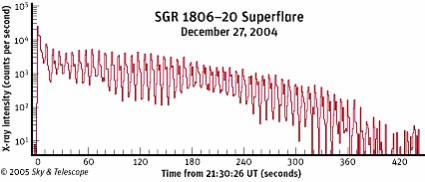
Credit: Steve Boggs / RHESSI Team / NASA / UC
The vertical axis is in a logarithmic scale. Note, how massive is the initial spike of energy. Strong pulses followed, occurring every 7.56 seconds, which was equal to the rotation period of SGR 1806-20.
The sudden disturbance to our planet’s upper atmosphere from the blast was observed by amateur radio solar observers. The American Association of Variable Star Observers detected the superflare’s ionizing effects on Earth’s ionosphere. The impact was even obvious on the planet’s daylight hemisphere. Solar observer Paul Campbell of Edmonton, Alberta, recorded this sudden disturbance in Earth's upper atmosphere (the ionosphere). The disturbance was observed at the very moment that the burst of high-energy radiation from SGR 1806–20 hit our planet on December 27, 2004. Campbell's homemade antenna and receiver setup was monitoring the 24.8-kilohertz radio signal from the US Navy's 250-kilowatt transmitter in Jim Creek, Washington when it recorded a sharp increase in the signal's strength.
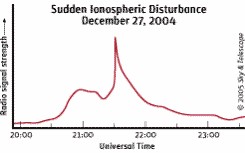
Credit: Paul Campbell / AAVSO
The massive stress induced on Earth's magnetosphere as a result of SGR 1806-20 superflare was definitely what triggered the (9.1-9.3M) earthquake off the west coast of northern Sumatra. According to the USGS, it was the third biggest earthquake ever recorded, but some other earthquake monitoring centers recorded it as the second biggest ever at 9.3M. The earthquake took place December 26, 2004, at 00:58:53 UTC. On the other hand, orbiting satellites and space probes detected the burst from SGR 1806-20 superflare at 21:30:26 UTC. Due to this time difference, scientists think there’s no correlation between the two events. This belief is correct based on current physics. But, in reality, there is a correlation, a strong one. In fact, the galactic storm induced huge stress on Earth’s magnetosphere that did not only trigger the massive earthquake of December 26, 2004, but also temporarily changed the shape of Earth’s ionosphere by distorting the transmission of long wavelength. In other words, the anomalies of geomagnetic field as a result of that superflare was bigger than from most of the intense solar flares ever recorded. If this GRB had been much closer to the Solar System, it would have seriously damaged the Heliosphere and completely destroyed the Ozone layer.
Based on real physics, which requires revision of gravity and its laws, the impact of this galactic storm on our planet makes a perfect sense and can be explained easily. Since magnetic force is permanently present in the building blocks of matter, its speed of operation is instantaneous. Therefore, any intense energetic event from the dense parts of the Universe would generate instantaneous impact on all magnetic fields. The impact, nevertheless, would drop off in intensity inversely with distance traveled (1/r). For this reason, galactic explosions usually have much higher impact on the Solar System than extragalactic explosions, even if the later were more powerful. The impact of the superflare of SGR 1806-20 on Earth’s magnetic field occurred simultaneously with the time of the explosion and preceded the actual gamma radiation effect that was observed slightly afterward. Furthermore, this energetic event showed the enormous variations of the speed of light. The real velocity of the gamma photons of SGR 1806-20 by far exceeded the so-called limited speed of light (C). The gamma photons reached Earth’s magnetosphere in less than two days.
Concluding remarks
It is high time to understand that our planet is permanently linked to the cosmos. All interactions and energetic events on cosmological scales affect or impact our planet in one way or another. Energetic events that take place within our galaxy can influence the Solar System within a very short period of time. The physics of isolationism and self-sufficient, which is based partially on the misunderstanding of the force of gravity, and partially on the discrete notion of the probability theory of quantum mechanics, in addition to the theories of relativity (special&general) are the most serious obstacles that do not allow us to understand our unified Universe. The Universe exists as a coherent entity. It is absolutely unified by the magnetic force, which is permanently present in the building blocks of matter. For this reason. we are not isolated from events that take place on any scale. Of course, the impacts of energetic events are determined by the distance and the intensity of those events. A strong blast of a supernova or Gamma Ray Burst from the dense regions of our galaxy can shake the entire Solar System. And the impact of such energetic explosions would be felt instantly since magnetic fields are continuous. The notion of limited speed of propagation of an energetic event, dictated by the so-called speed of light had, and continues to have, a devastating consequence on the development of physics. In the last few decades, we have observed so many cosmological phenomena that clearly showed the flaws of this theoretical concept. But, in spite of these observations that are increasing with every new generation of space telescopes and other detecting and observing instruments, both on land and in space, physicists refuse to even question the notion of limited speed of light. In fact, the opposite is taking place, these observations are enforced into this theoretical concept, by inventing new theoretical assumptions, like the invention of an imaginary particle, new exotic matter or mystery substance that cannot be detected or observed.
Without revising the force of gravity and accepting it as an attractive weak magnetic force that operates between adjacent magnetic fields when the difference in strengths between them is big (or rather not zero) and without discarding the metaphysics and pseudo-physics theories of the 20th century, real progress is impossible. In addition to the distortion of the physical reality of the Universe, the theoretical physics of the 20th century did not have any practical benefits to mankind. There are so many claims that GPS works on the principle of special relativity and the transistor is the result of Quantum Mechanics (QM), and quantum computer (QC) would be built etc. In reality, however, these claims are scientifically groundless. On the other hand, if we can one day go back to the drawing board and revise the force of gravity and discard the myths of the 20th century physics, then surely we can produce the most ideal energy source and be able to manufacture technologies that will allow us to explore the Universe in ways beyond the imagination of science fiction writers.
"The Observed Influence of Gamma-Ray Bursts on Earth’s Magnetic Field" was written by Jamal S. Shrair, Founder of the Helical Universe, on June 24, 2016. Published by The Watchers on July 6, 2016.
Featured image: Artist’s impression of the magnetar in the star cluster Westerlund 1. Credit: ESO/L. Calçada

Commenting rules and guidelines
We value the thoughts and opinions of our readers and welcome healthy discussions on our website. In order to maintain a respectful and positive community, we ask that all commenters follow these rules.